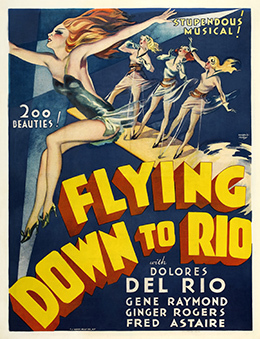| << Chapter < Page | Chapter >> Page > |
For more on “Brother Can You Spare a Dime?” and the Great Depression, visit ArtsEdge to explore the Kennedy Center’s digital resources and learn the “Story Behind the Song.”
Finally, there was a great deal of pure escapism in the popular culture of the Depression. Even the songs found in films reminded many viewers of the bygone days of prosperity and happiness, from Al Dubin and Henry Warren’s hit “We’re in the Money” to the popular “Happy Days are Here Again.” The latter eventually became the theme song of Franklin Roosevelt’s 1932 presidential campaign. People wanted to forget their worries and enjoy the madcap antics of the Marx Brothers, the youthful charm of Shirley Temple, the dazzling dances of Fred Astaire and Ginger Rogers ( [link] ), or the comforting morals of the Andy Hardy series. The Hardy series—nine films in all, produced by MGM from 1936 to 1940—starred Judy Garland and Mickey Rooney, and all followed the adventures of a small-town judge and his son. No matter what the challenge, it was never so big that it could not be solved with a musical production put on by the neighborhood kids, bringing together friends and family members in a warm display of community values.

All of these movies reinforced traditional American values, which suffered during these hard times, in part due to declining marriage and birth rates, and increased domestic violence. At the same time, however, they reflected an increased interest in sex and sexuality. While the birth rate was dropping, surveys in Fortune magazine in 1936–1937 found that two-thirds of college students favored birth control, and that 50 percent of men and 25 percent of women admitted to premarital sex, continuing a trend among younger Americans that had begun to emerge in the 1920s. Contraceptive sales soared during the decade, and again, culture reflected this shift. Blonde bombshell Mae West was famous for her sexual innuendoes, and her flirtatious persona was hugely popular, although it got her banned on radio broadcasts throughout the Midwest. Whether West or Garland, Chaplin or Stewart, American film continued to be a barometer of American values, and their challenges, through the decade.
The Great Depression affected huge segments of the American population—sixty million people by one estimate. But certain groups were hit harder than the rest. African Americans faced discrimination in finding employment, as white workers sought even low-wage jobs like housecleaning. Southern blacks moved away from their farms as crop prices failed, migrating en masse to Northern cities, which had little to offer them. Rural Americans were also badly hit. The eight-year drought that began shortly after the stock market crash exacerbated farmers’ and ranchers’ problems. The cultivation of greater amounts of acreage in the preceding decades meant that land was badly overworked, and the drought led to massive and terrible dust storms, creating the region’s nickname, the Dust Bowl. Some farmers tried to remain and buy up more land as neighbors went broke; others simply fled their failed farms and moved away, often to the large-scale migrant farms found in California, to search for a better life that few ever found. Maltreated by Californians who wished to avoid the unwanted competition for jobs that these “Okies” represented, many of the Dust Bowl farmers were left wandering as a result.
There was very little in the way of public assistance to help the poor. While private charities did what they could, the scale of the problem was too large for them to have any lasting effects. People learned to survive as best they could by sending their children out to beg, sharing clothing, and scrounging wood to feed the furnace. Those who could afford it turned to motion pictures for escape. Movies and books during the Great Depression reflected the shift in American cultural norms, away from rugged individualism toward a more community-based lifestyle.

Notification Switch
Would you like to follow the 'U.s. history' conversation and receive update notifications?